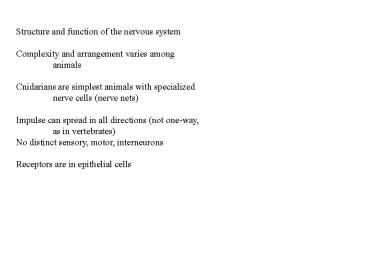Structure and function of the nervous system - PowerPoint PPT Presentation
1 / 45
Title:
Structure and function of the nervous system
Description:
No distinct sensory, motor, interneurons. Receptors are in epithelial cells ... trained voluntary activity. Myencephalon. Medulla oblongata- brain stem- everything ... – PowerPoint PPT presentation
Number of Views:66
Avg rating:3.0/5.0
Title: Structure and function of the nervous system
1
Structure and function of the nervous
system Complexity and arrangement varies
among animals Cnidarians are simplest animals
with specialized nerve cells (nerve
nets) Impulse can spread in all directions (not
one-way, as in vertebrates) No distinct sensory,
motor, interneurons Receptors are in epithelial
cells
2
Flatworms are the simplest animals with
bilateral nervous systems Cephalization-clusteri
ng of nerve cells represents a simple
brain Nervous systems are as complex as they
need to be
3
(No Transcript)
4
Vertebrate nervous systems central
and peripheral
5
(No Transcript)
6
(No Transcript)
7
(No Transcript)
8
Lined with ciliated ependymal cells
9
Ventricles are filled with cerebrospinal
fluid formed in brain conveys nutrients and
other necessary substances to brain acts as
shock absorber
10
(No Transcript)
11
Human cerebrum is formed into two
hemispheres Each hemisphere contains functional
lobes
12
(No Transcript)
13
(No Transcript)
14
(No Transcript)
15
Cerebral lateralization Each hemisphere can
control activities on the opposite side of the
body Each hemisphere can receive information
from both sides due to corpus callosum Each
hemisphere specializes in certain activities
16
(No Transcript)
17
(No Transcript)
18
Comprehension
19
(No Transcript)
20
Basal nuclei Clusters of nerve cell bodies Help
control voluntary movement disorders have been
identified in which nuclei degenerate
(Huntingdons disease) neurons that respond to
dopamine are damaged (Parkinsons
disease) overactivity of dopamine in limbic
system may contribute to schizophrenia
21
(No Transcript)
22
(No Transcript)
23
Limbic system and hypothalamus- emotions Limbic
system- nuclei and tracts around brain
stem aggression fear feeding (satiety) sex
drive reward/punishment Behaviors associated
with survival
24
Limbic system is connected with
prefrontal cortex Emotions and memories
contribute to behavior
25
Many areas of brain contribute to
memory Short-term Long-term Working memory?
(integrated) Short-term gathered into long-term
by temporal medial lobe Left medial lobe-
words Right medial lobe- images Hippocampus very
important for consolidation Amygdala- fear
emotions
26
Memories appear to be stored in
various particular parts of brain, which
must be retrieved for a complete memory Why is
long-term memory more durable than short
term? storage capacity practice Long-term
potentiation- neurons are stimulated and remain
especially excitable Neurons actually grow more
dendrites!
27
Forebrain comprised of cerebrum
and diencephalon Thalamus/epithalamus Hypothalam
us Pituitary gland Thalamus- relay center to
cerebrum all sensory information except
smell alertness epithalamus- includes pineal
gland (melatonin)
28
Hypothalamus- integrates nervous and endocrine
systems Regulates pituitary Hunger and
thirst Body temperature Emotions Autonomic and
endocrine responses are coordinated here
29
Forebrain comprised of cerebrum
and diencephalon Thalamus/epithalamus Hypothalam
us Pituitary gland Thalamus- relay center to
cerebrum all sensory information except
smell alertness epithalamus- includes pineal
gland (melatonin)
30
Hypothalamus- integrates nervous and endocrine
systems Regulates pituitary Hunger and
thirst Body temperature Emotions Autonomic and
endocrine responses are coordinated here
31
Hindbrain Metencephalon pons (bridge)-
cranial nerve tracts respiratory
control cerebellum- motor coordination motor
learning- ataxia caused by damage to this
area trained voluntary activity
32
Myencephalon Medulla oblongata- brain stem-
everything must pass through it Many crossed
tracts (pyramids) relay sensory
information cardiovascular responses breathing
RAS- nonspecific activation (wakefulness)
33
(No Transcript)
34
(No Transcript)
35
Spinal cord tracts Ascending- send sensory
information to brain Descending-
motor pyramidal- from precentral gyrus (in
cerebrum motor cortex) (corticospinal
tracts) directly into spinal cord other cells
in cortex also contribute many fibers cross
over fine motor activity
36
Extrapyramidal Originate in midbrain and brain
stem many synapses Reticulospinal tracts- many
originate in RAS other tracts activated
37
(No Transcript)
38
Cranial and spinal nerves 12 pairs of cranial
nerves most are mixed nerves except for
those that detect special senses (sensory
only) 31 pairs of spinal nerves- mixed nerves
but separate at ganglion dorsal root-
sensory ventral root- motor Cell bodies of some
autonomic neurons in ganglia outside of spinal
cord
39
(No Transcript)
40
Reflex arc- involuntary response to a
stimulus May consist of a single synapse May
not directly involve the brain at all Some are
much more complicated
41
(No Transcript)
42
(No Transcript)
43
(No Transcript)
44
Spinal reflexes Withdrawal Postural Emptying
(urination, etc.) Can be overridden by higher
brain centers Some local responses are not
controlled by nerves or hormones (blood
vessel dilation, inflammatory response, etc.)
45
How are sensory input and motor output
coordinated in our brains What are the
specific sensory receptors and how do they
discriminate stimuli? What is the structural
basis (skeletomuscular system, and specialized
muscles) for a motor response?































